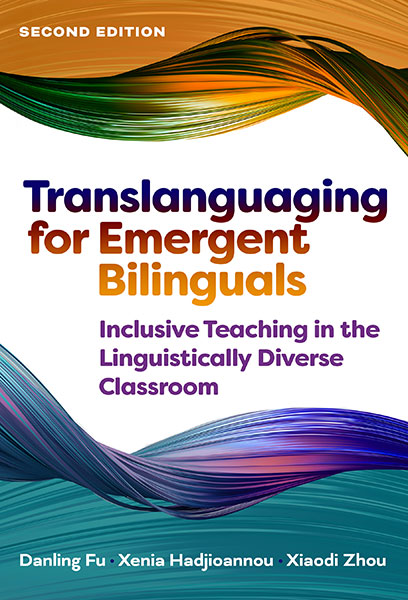Professors: Request an Exam Copy
Print copies available for US orders only. For orders outside the US, see our international distributors.
Second Edition
Danling Fu, Xenia Hadjioannou, Xiaodi Zhou
Foreword by: Ofelia García
Publication Date: December 19, 2025
Pages: 176
Series: Language and Literacy Series

This updated edition offers a readable and practical explanation of what translanguaging is and how it can be used to inform instruction in K–12 schools.
Through engaging vignettes from a variety of monolingual and translanguaging settings, this book traces the challenges encountered by emergent bilingual students (EBs) and the schools that serve them and recommends promising solutions. Find additional chapter resources, companion videos, and more at translanguagingforebs.com.
Each chapter of this second edition has been updated to reflect new scholarship in translanguaging theory and practice, address and clarify common criticisms of translanguaging, and speak to current challenges to implementing translanguaging-informed practices. Among the updates are expanded content on dual-language bilingual programs, critical literacy, working with children who have experienced war and displacement, new and emerging technologies such as translation tools and artificial intelligence chatbots, and language-focused instruction in translanguaging classrooms. The book ends with concrete takeaways for successfully adopting translanguaging in different education settings.
By embracing home languages and cultures, this approach nurtures the development of multiple literacies, enabling individuals to thrive academically, socially, linguistically, and intellectually.
Book Features:
Danling Fu is emeritus professor at the University of Florida and a literacy consultant for the bilingual program in the New York City school districts and for English education in Fengxian school districts, Shanghai, China. Xenia Hadjioannou is professor of language and literacy education at Penn State University’s Berks campus. Xiaodi Zhou is an associate professor of literacy studies at the University of Texas Rio Grande Valley.
“This book offers an uplifting alternative view of the lives and education of language-minoritized students. The authors present here a practice-based approach to translanguaging for all types of teachers of emergent bilinguals.”
—From the Foreword by Ofelia García, professor emerita, The Graduate Center, City University of New York
“Through vignettes and careful explanations, this book demystifies translanguaging and shows teachers how to meaningfully weave it into instruction. The authors address questions that educators may have with care, making translanguaging theory and pedagogy accessible and practical. Readers will leave with the idea that creating a translanguaging classroom is not only possible but also a sustainable and transformative goal.”
—Laura Ascenzi-Moreno, professor, Bilingual Program Coordinator & Undergraduate Deputy, Childhood, Bilingual, and Special Education Department, Brooklyn College, CUNY
“The new edition of this successful volume offers practical as well as theoretical insights into translanguaging pedagogy. Its unique value is the focus on emergent bilinguals and its rich empirical evidence to show how translanguaging can be used as a positive and productive approach to learning. It is an important resource for practitioners, policymakers, and researchers in inclusive and culturally responsive bilingual education.”
—Li Wei, director and dean, University College London Institute of Education
“The second edition of Translanguaging for Emergent Bilinguals is both timely and transformative. Grounded in deep classroom wisdom, it illuminates how translanguaging can nurture equity, belonging, and joy in multilingual learning spaces. A vital guide for educators committed to honoring the full humanity and linguistic repertoires of emergent bilinguals.”
—Zhongfeng Tian (田中锋), associate professor of bilingual education, Rutgers University–Newark
Professors: Request an Exam Copy
Print copies available for US orders only. For orders outside the US, see our international distributors.